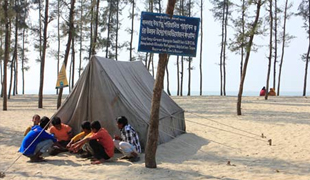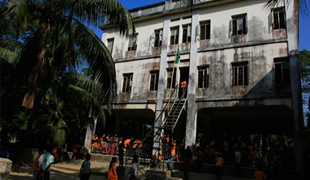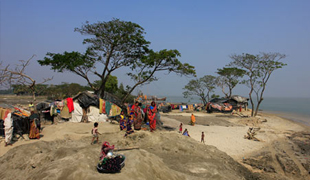Sea change: the Bay of Bengal's vanishing islands
29 January 2013
Rapid erosion and rising sea levels are increasingly threatening the existence of islands off the coast of Bangladesh and India
John Vidal in Cox's Bazar
Jump to comments (136)
|
Schoolteacher NurulHashem lives in a grass hut set among coconut palms and pine trees, yards from a pristine beach on the sparkling Bay of Bengal. It sounds idyllic, but he longs to return to the island of Kutubdia, 50 miles away, where his family home has been swallowed by ever-rising tides and is now out at sea under several feet of water.
|

Disappearing world … a project for climate refugees near Cox's Bazar, as people have been forced from islands such as Kutubdia in the Bay of Bengal. Photograph: Salman Saeed
|
To make matters worse, the local government, which welcomed him when he arrived three years ago, wants him and thousands of other families who have fled to the coast from the island, to make way for an airport and hotel developments.
Kutubdia is one of many islands off Bangladesh and India affected by increasingly rapid erosion and some of the fastest recorded sea-level rises in the world. These "vanishing islands" are shrinking dramatically. Kutubdia has halved in size in 20 years, to about 100 sq km. Since 1991 six villages on the island of fishermen and salt workers have been swamped and about 40,000 people have fled. Like Hashem, most have relocated to the coast near Cox's Bazar.
"The sea water is rising every day," says Hashem, who calls himself a climate refugee.
"We lost everything. We are not happy, because we must move again.Climate change is making thousands of people homeless."
 Kutubdia's cyclone shelter, which doubles up as a school. Photograph: Salman Saeed
Kutubdia's cyclone shelter, which doubles up as a school. Photograph: Salman Saeed
|
The 80,000 people left on Kutubdia all expect to follow Hashem. "The land here used to be 1km out to sea," says Mohamed Rashed from the village of Qumira Char. "We lost mosques, a school, shops, farms. We are scared of the sea now. Gradually it comes closer to our homes. When we sleep, we are scared. Every year the tide rises more and comes in further. Next year this village may not exist."
|
Rashed moved his house on to a new three-metre high concrete embankment in 2008, but the high tides and tidal surges now top the barrier.
"God knows how long this village will last. If it gets worse I will have to go to the mainland. We know the end is coming," says fisherman JakirHossain.
At the current rate of erosion Kutubdia will be off the map within 30 years, along with dozens of other coastal islands. Sandwip, near Chittagong, covered 600 sq km 50 years ago. It is now a tenth of the size, its area having halved over the past 20 years alone. Further north along the Bay of Bengal, 12 islands – home to 70,000 people – are said by the Bangladeshi government to be "immediately threatened" by the rising seas; 90 others in Indian waters, collectively housing more than 4 million people, are said to be at real risk. Sagarisland is expected to lose at least 15% of its area in the next eight years, and may yet suffer the same fate that befell the island of Lohachara, which in December 2006 became the first inhabited island known to be lost to rising sea levels.
|
Scientists attribute the disappearance of these islands to a combination of natural and possibly manmade events. The villagers say they are victims of climate change, but there is no reliable sea-level data in Bangladesh. However, sea surface temperatures in the Bay of Bengal have significantly increased, which could theoretically have caused the expansion of water. In addition, more intense cyclones and higher tides have also been observed, while increased flows from some of the giant rivers that flow into the Bay of Bengal may also be contributing.
|

|
"There is a close correlation between the rate of sea-level rise and the sea surface temperature," says SugataHazra, head of oceanography at Kolkata's Jadavpur University.
No scientific monitoring of sea-level rise has been done on Kutubdia, but increases of nearly 8mm a year have been recorded over 20 years at Cox's Bazar. This is nearly three times the average for Bangladesh and up to five times the worldwide average sea-level rise.
"Land has always been lost to erosion in the Bay of Bengal, but this is now becoming exacerbated," says SaleemulHuq, senior fellow at theInternational Institute for Environment and Development in London.
"There has been a step change in the numbers who have had to move and the rate of erosion is higher than in the past. Whether it is climate change is not clear, but this can be seen as the beginning of a trend which is expected to grow exponentially." .
Predicted sea-level rises of up to a metre over the next century would inundate the homes of millions of people. At the present rate of 8mm a year it may only take about 25 years to raise levels 20cm, enough to permanently waterlog and destroy the land and drinking water of as many as 10 million people in the south of the country. A one-metre rise along the only partly defended 450 mile (720km) Bangladeshi coastline would result in nearly 20% of the country being submerged and 30 million more people being displaced. A recent report prepared byJadavpur University and the World Wide Fund For Nature (WWF)estimates that a million of the 5 million people living in the delta will become climate change refugees by 2050.
"We are staring catastrophe in the face," says Moqbul Ahmed, team leader with Coast, a social group working with climate-affected communities and refugees on Kutubdia and elsewhere. "They lose everything they have and they cannot recover when their land is washed away. They have no option but to migrate from the islands but they have no money, and when they leave they have no schools or hospitals. They have no work and no future."
On Kutubdia, islanders say they do not need scientists to tell them that the annual sea-level rise is far more than 8mm. "We reckon its twice that at least," says Hashem. "The sea used to be much further away. We had to move our houses 300 yards in 2008, but the water now comes to the house. We have nowhere left to go. If we had any money we would go to Cox's Bazar or Chittagong. All we can do is fish. We cannot protect ourselves. So we stay. Our life is with the sea."
Source:
http://www.guardian.co.uk/global-development/2013/may/07/safe-drinking-water-disappearing-bangladesh

